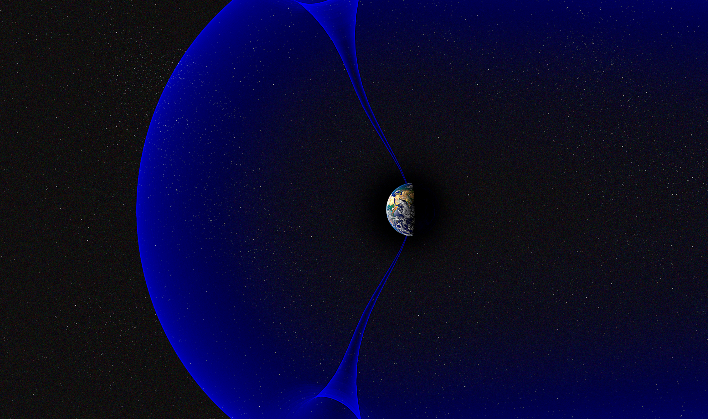NASA To Launch Rocket Over The North Pole To Investigate Mysterious Space Speed Bump And Santa Approves

NASA has been extremely busy as of late with launching various missions such as DART, which aims to purposely slam a satellite into an asteroid and change its course, and Artemis, which aims to put human-kind back on the surface of the moon by the end of the decade. But the past couple of years have not always been kind to NASA's planning. One mission that saw setbacks in prior years was part of the Grand Challenge Initiative-CUSP, and it ended up being delayed due to space weather conditions and the COVID-19 pandemic. That mission, Cusp Region Experiment-2 (CREX-2), is now nearing another possible launch and hopes to solve a long-time mystery.
Around noon local time at the North Pole, a funnel-shaped gap in Earth's magnetic field passes overhead. It is this magnetic field that protects us mortals from the solar wind caused by the stream of charged particles erupting off the Sun. The gap that is caused by the disturbance in the magnetic field, called the polar cusp, permits the solar wind with a direct line of access to Earth's atmosphere.
The gap also produces some anomalies that have perplexed scientists over the last 20 years. As radio and GPS signals pass through this part of the sky, they begin behaving strangely. But perhaps even more perplexing is that as spacecraft pass through the region of atmosphere they actually slow down. Mark Conde, a physicist at the University of Alaska Fairbanks and the principal investigator for NASA's Cusp Region Experiment (CREX-2) explained, "At around 250 miles above Earth, spacecraft feel more drag, sort of like they've hit a speed bump."
The air that is encountered is noticeably denser than anywhere else where a spacecraft travels while in orbit of the Earth. While scientist know this much, they do not know why or how this occurs. They hope that the data collected by CREX-2 will give them some insight to this mystery. They can then take that knowledge to better anticipate changes in a spacecraft's trajectory.
NASA scientist are hopeful this time around that they will be successful, as opposed to two years ago when the mission was delayed due to space weather conditions and a global pandemic. This time the Sun is in a more active stage of its natural cycle, too. This increases the opportunities that space weather conditions will be favorable for CREX-2 to study this dense region of Earth's atmosphere.
The Earth's atmosphere decreases rapidly as it goes higher, but maintains as it goes horizontally. This means that at any given point in altitude, the atmosphere is approximately the same density around the globe. This is not the case, however, when it comes to the polar cusp. At around 250 miles up, the density of the atmosphere is about one and a half times denser than other air at the same altitude. Conde said, "You can't just increase the mass in a region by a factor of 1.5, and do nothing else, or the sky will fall." It appears that something invisible is supporting the extra mass and NASA hopes to find out what that is with CREX-2.
There are a couple of possible explanations. The first involves electric and magnetic effects in the ionosphere. The ionosphere is the layer of Earth's upper atmosphere that is ionized by the Sun. It is thought that electrodynamics could be supporting the denser air indirectly, or it may be producing heat that generates vertical winds to keep the air afloat. CREX-2 has been given instruments designed to measure these effects.
Another possibility could be that air in the whole vertical column of the cusp is simply denser than its surroundings. This could cause the dense air 250 miles high to be buoyant. However, a column of heavier air should also generate horizontal or even vortex-like winds. CREX-2 has been designed to look for this as well.

Conde said, "It's quite a big chess game." This is because the mission requires complicated logistics. As the tracers emit their light, the team will need to view them from several different vantage points in order to get a comprehensive understanding of the wind patterns. Scientists will be positioned throughout Scandinavia to capture photographs of the tracers over a 20-30 minute period. One student will be aboard a plane flying from Reykjavik, Iceland to capture photos, while others will do so from two sites on the Norwegian island of Svalbard.
Conde stated, "We are threading a needle. We get about an hour or two each day when conditions are suitable to do the experiment." To compound the issue at least two of the stations need a clear view of the tracers to be able collect sufficient data. In 2019 the launch window was open for 17 days, and not one of those days were suitable for the mission to flight.
Conde is hopeful that this winter will be the right time for CREX-2 to take flight and hopefully answer some questions about the polar cusp. He said, "You'll spend two or three years developing a payload, but ultimately, it all comes down to choosing when to press the button to capture the science you want."

